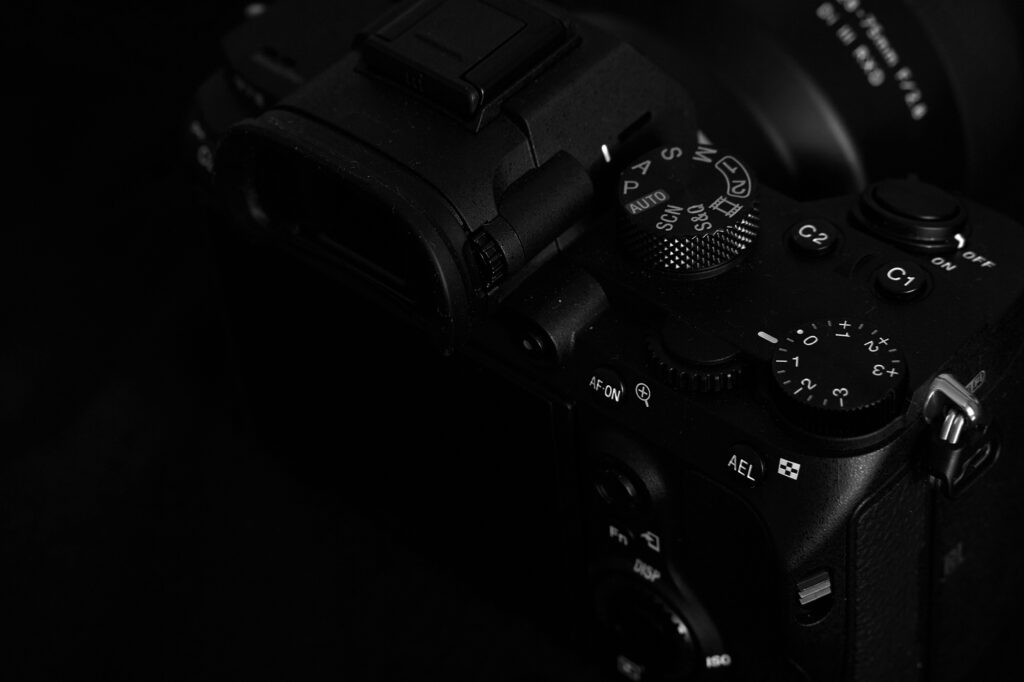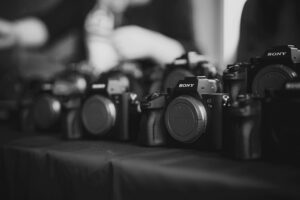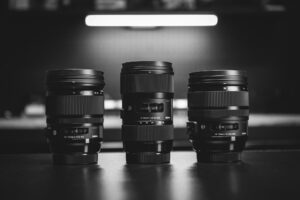When you’re buying your first camera, the list of features and specifications can feel overwhelming. What do all these numbers and acronyms really mean? And which ones actually matter? Whether you’re getting into photography or video, understanding the specs will help you make a smarter, more confident decision. This post breaks down the most essential camera features in simple terms, so you know exactly what to look for (and what to ignore) when choosing your next camera.
If you’re still deciding which model to get, start with our how to choose a camera guide.
TL;DR
- Shutter speed, ISO, and aperture form the exposure triangle, the core of how light is captured.
- LCD screens vary in resolution, touch capability, and whether they flip out for vlogging or selfies.
- Viewfinders come in two types: optical (DSLR) and electronic (mirrorless), each with pros and cons.
- Zoom & focal length affect how close your subject appears. Know the difference between optical and digital zoom.
- Kit lenses are basic zooms that come bundled with a camera. They’re good for learning, but limited.
- IBIS (In-Body Image Stabilization) helps reduce blur from shaky hands, especially helpful for handheld shooting.
- Autofocus systems vary by brand and camera class. Some track eyes, faces, and even animals.
- Burst mode (continuous shooting) is important for sports, action, and wildlife photography.
- Battery life is crucial if you shoot long sessions or travel. DSLRs tend to last longer than mirrorless models.
- Dual card slots offer peace of mind for backups or separating photo and video files.
- Wi-Fi, Bluetooth, and USB-C let you transfer files easily and connect to apps or accessories.
- Weather sealing protects your camera from dust and light rain, ideal for outdoor shooters.
- Live streaming and webcam support are must-haves for content creators and remote work setups.
- AI features like subject detection or scene recognition can be helpful, especially for beginners.
This post is just one part of my “Camera Buying Guide“, which you can download as a pdf file right now.
Understanding the Exposure Triangle: Shutter Speed, ISO, and Aperture
The three settings that control exposure in any digital camera are:
- Shutter Speed (how long the sensor is exposed to light)
- ISO (the sensitivity of the sensor to light)
- Aperture (how wide the lens opening is)
Together, these form the exposure triangle, and each has trade-offs.
- Shutter speed: Faster speeds (like 1/4000s) freeze motion but let in less light. Slower speeds (like 1/30s) brighten the image but risk motion blur.
- ISO: Increasing ISO brightens your image but adds noise. Better cameras (especially full-frame) handle high ISO with less noise.
- Aperture: A wider aperture (lower f-number like f/1.8) lets in more light and creates a shallow depth of field (more background blur). A narrower aperture (like f/11) keeps more of the image in focus.
In compact cameras, you can’t change lenses, so you’ll want to check the maximum and minimum aperture range built into the lens. For example, a lens with an aperture range of f/2.8-5.6 means you’ll get more light at the wide end than when zoomed in.
Most modern cameras have a maximum shutter speed of 1/4000 or 1/8000 of a second, important if you plan to shoot fast action like sports or wildlife. On the slow end, most cameras allow shutter speeds up to 30 seconds. For long exposure shots (like night sky photography), you’ll want a camera that also offers Bulb mode, which lets you control longer exposures manually or via remote.
When considering ISO, note both the normal ISO range and the extended ISO range of a camera. Extended ISO is useful in emergencies but usually adds significant noise. Full-frame cameras generally offer a much wider and cleaner usable ISO range than crop-sensor or compact cameras, which is especially helpful in low light.
For a deeper dive into the exposure triangle, see our guide on mastering exposure.
LCD Screen Types and What to Look For
Digital camera LCD screens mostly fall into three main types:
- Fixed screen – Doesn’t move. Found on many budget models.
- Tilting screen – Moves up/down but not sideways. Great for overhead or low-angle shots.
- Fully articulating screen – Flips to the side and rotates in all directions. Ideal for vlogging, selfies, and creative angles.
Another distinction: touchscreen vs. non-touchscreen. While not essential, a touchscreen can speed up menu navigation and focusing. Check the camera specs if this feature matters to you.
Electronic vs. Optical Viewfinders
A viewfinder lets you frame your shots without using the LCD screen. Most entry-level compact cameras don’t include one, relying solely on the screen.
There are two types:
- Optical viewfinder (OVF) – Found in DSLRs, uses a mirror system to show you the real scene.
- Electronic viewfinder (EVF) – Found in mirrorless and some advanced compact cameras, displays a digital preview.
Both have pros and cons, but if you’re shooting in bright light, having a viewfinder (of either type) is a big plus.
A Note on Resolution for LCDs and Viewfinders:
When comparing cameras, don’t just look at whether the screen or viewfinder flips or is touch-enabled, pay attention to resolution too.
- LCD resolution is usually measured in dots or pixels, and a sharper screen can help with focusing, checking details, and reviewing images on the spot.
- EVF (Electronic Viewfinder) resolution is especially important in mirrorless cameras. A low-res EVF may appear grainy or laggy, while a high-res one feels more natural and accurate when framing your shot.
Higher resolution displays make your shooting experience more enjoyable and reduce the risk of missed focus or exposure errors.
Zoom Explained: Optical vs. Digital & Understanding Focal Length
Zoom describes how far a lens can magnify a subject. It’s calculated as:
Maximum focal length ÷ minimum focal length = zoom factor
For example, a 24-240mm lens gives you a 10x zoom.
There are two kinds of zoom:
- Optical zoom (real lens movement, maintains image quality)
- Digital zoom (crops into the image, reduces quality: avoid using this)
In compact cameras, zoom is usually built in. In DSLRs and mirrorless cameras, you can change lenses, which gives you more control over focal length and quality.
For cameras with sensors smaller than full-frame (like APS-C or Micro Four Thirds), remember that focal lengths are “crop-adjusted.” A 50mm lens on an APS-C sensor will behave more like an 75 or 80mm equivalent in full-frame terms. This is important when choosing lenses for portraits, landscapes, or telephoto shots.
What Is a Kit Lens and Should You Use One?
Many entry-level DSLRs and mirrorless cameras are sold with a kit lens, usually an 18-55mm or 16-50mm zoom.
These are versatile lenses to start with, but not always the highest quality. Some cameras can be bought body-only, which lets you choose your first lens separately: useful if you have a specific goal (like portraits or macro work).
We’ll dive deeper into choosing your first lens in later posts, but for now: if you’re just starting out, a kit lens is usually good enough to learn with.
In-Body Image Stabilization (IBIS) and Why It Matters
In the past, you needed a lens with built-in optical stabilization to reduce hand shake. But many modern cameras -especially mirrorless ones- now offer in-body image stabilization (IBIS). This means the sensor itself moves slightly to compensate for small vibrations or movement.
The major advantage? It works with any lens, even older manual lenses that lack stabilization. If you plan to shoot video handheld or take photos in low light, IBIS is a feature you’ll really appreciate.
How Autofocus Systems Work in Modern Cameras
Autofocus systems have become incredibly advanced. Newer cameras offer features like:
- Eye Detection AF (for humans or animals)
- Subject tracking
- Continuous and smooth AF for video
If you’re planning to shoot portraits, fast-moving subjects, or vlogs, make sure the camera has:
- Accurate and fast AF in both photo and video modes
- Reliable tracking even when the subject is moving
- Quiet focus motors (especially important for video recording)
Continuous Shooting (Burst Mode) for Action Photography
Burst mode allows your camera to take multiple photos per second while you hold the shutter button. This is vital for action, wildlife, and sports photography.
The speed is measured in frames per second (fps). Some beginner cameras offer 5 fps, while higher-end models can go up to 20+ fps. Also check if the camera can shoot continuously in RAW, as many entry-level models limit burst speed to JPEG only.
Battery Life in Cameras: What You Need to Know
One common issue with mirrorless cameras, especially earlier models, is shorter battery life, since the sensor is always active (feeding data to the screen and electronic viewfinder). DSLRs, in contrast, can often shoot hundreds more shots per charge.
Look for the CIPA-rated battery life in the specs. If you expect to shoot long sessions, you may need:
- Extra batteries
- A battery grip
- Or even a camera that supports USB-C charging on the go
Dual Card Slots: Do You Really Need Them?
Many mid-range to professional cameras offer dual memory card slots. This gives you more flexibility and peace of mind:
- Save RAW files to one card and JPEGs to the other
- Record the same photos to both cards simultaneously for instant backup
- Automatically switch to the second card when the first one fills up
If you’re working on important projects or shooting client work, dual slots can be a lifesaver.
Wi-Fi, Bluetooth, and USB-C: Camera Connectivity Options
Most modern cameras include Wi-Fi and Bluetooth, letting you:
- Instantly transfer photos to your phone or laptop
- Control the camera remotely from a mobile app
- Upload or edit content on the go
Some models also support USB-C, which can be used for:
- Faster file transfers
- In-camera charging
- Even live streaming or webcam use in some cases
If you’re a content creator or just like working wirelessly, strong connectivity options are a must.
Weather-Sealed Cameras: Are They Worth It?
If you plan to shoot outdoors, especially in unpredictable environments -rain, dust, snow, or humidity- look for a camera with weather sealing.
Weather-sealed cameras typically have rubber gaskets and reinforced body construction to resist moisture and dirt.
Note:
- Weather-sealing doesn’t mean “waterproof.” Don’t submerge your camera.
- You’ll also need weather-sealed lenses to get full protection.
For travel, documentary, landscape, or wildlife photography, weather resistance is worth the investment.
Live Streaming and Using Your Camera as a Webcam
Many newer cameras now offer built-in live streaming or webcam functionality over USB.
If you’re planning to create content on YouTube, Twitch, or Zoom, this is a powerful and convenient feature.
Look for:
- Clean HDMI out (no overlays)
- USB streaming compatibility
- Plug-and-play webcam support without needing a capture card
- Support for vertical video recording (great for social media)
This allows you to turn your camera into a professional-quality webcam, dramatically upgrading your video calls and streams.
AI-Powered Camera Features: Are They Useful or Gimmicks?
High-end and even mid-range cameras are beginning to incorporate AI-powered tools to make your workflow smoother. Some of the most useful include:
- AI-based autofocus that recognizes human eyes, animal faces, vehicles, birds, and more
- Auto-framing in video, where the camera digitally crops to follow your movement
- Scene detection, where the camera adjusts exposure or tone based on what it “understands” in the frame
AI features are especially useful for:
- Vloggers and solo creators
- Wildlife photographers
- Fast-paced environments where you need reliable automation
While still an emerging field, AI tools are quickly becoming essential in modern hybrid cameras.
Reminder: This post is just one part of my “Camera Buying Guide“, which you can download as a pdf file right now.
Last Words
Camera specs aren’t just marketing jargon, they directly affect how your camera performs in real-life shooting situations. By understanding what features align with your style of photography or video work, you can avoid overpaying for things you don’t need and focus on the tools that will actually help you grow. Use this guide as a reference any time you’re comparing models, and remember: the best camera is the one that works for you.
FAQ
What does the exposure triangle include?
Shutter speed, ISO, and aperture: the three essential settings that control your camera’’’s exposure and creative look.
Should I focus on megapixel count when choosing a camera?
Megapixels matter less than sensor size and lens quality. Higher resolution is only essential if you’re printing large or cropping heavily.
Why are features like IBIS and dual card slots useful?
IBIS reduces blur for handheld shots, and dual card slots offer backup or better file organization, valuable for travel and important shoots.




